Start with the Versatile Dahlias
This is the ideal time to buy and start off dahlia tubers, preferably under cool glass. Once the temperatures rise the tubers will sprout and grow on slowly, forming sturdier plants. Too much heat produces soft, leggy growth. If the temperatures look set to plunge at night, as they often can in spring, a triple layer of garden fleece should protect them. Serious gardeners will invest in a frost-breaking heater that cuts in and distributes the air. Cuttings can be taken once the new growth has reached three to four inches (up to 10cm). Using a sharp knife, cut above the tuber, leaving a section of stem to reshoot. You can also break pieces of tuber off with new growth to form a 'chicken leg' should you wish to produce more plants.
 The main thing to remember is to never plant a dahlia outside until early June for these frost-tender Mexican beauties will be reduced to mush by the slightest frost. Cold nights also check their growth, so bide your time. Stake as you plant, either with a specialist support or with a trio of canes and a circle of string. Slugs can be a problem too, but despite that every gardener should aspire to grow some dahlias, for they will flower from July until the late frosts if deadheaded. They come in a rainbow of colours and a variety of showy shapes that include scrolled star, spiky cactus, soft waterlily, tight ball and the single bee pleaser. Double forms last longer than singles, so there's less deadheading. Regardless of type, they all make good cut flowers and they can be accommodated in a vegetable garden or woven through a border. Wherever you grow them, given good light, they will flower abundantly. The main thing to remember is to never plant a dahlia outside until early June for these frost-tender Mexican beauties will be reduced to mush by the slightest frost. Cold nights also check their growth, so bide your time. Stake as you plant, either with a specialist support or with a trio of canes and a circle of string. Slugs can be a problem too, but despite that every gardener should aspire to grow some dahlias, for they will flower from July until the late frosts if deadheaded. They come in a rainbow of colours and a variety of showy shapes that include scrolled star, spiky cactus, soft waterlily, tight ball and the single bee pleaser. Double forms last longer than singles, so there's less deadheading. Regardless of type, they all make good cut flowers and they can be accommodated in a vegetable garden or woven through a border. Wherever you grow them, given good light, they will flower abundantly.
Dark and Dramatic
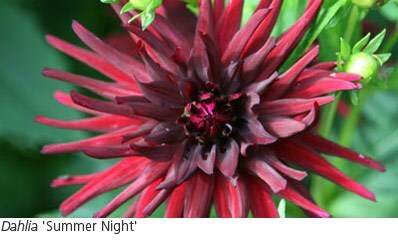
Dark dahlias in shades of red add depth and substance to border or vase. When yellow daisies begin to dominate autumn, as they always do, these sultry beauties add an ornate richness that makes the yellow daisies gleam like gold. 'Karma Choc' combines khaki-green foliage with velvet petals that hover between black and red. It's one the finest of the Karma Series, which were all bred for the cut flower market. Strong stems and lots of flowers are a feature in all Karmas.
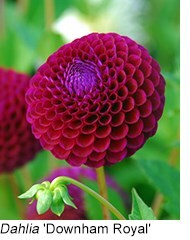 'Summer Night' (usually known as 'Nuit D'ete') is a spikier red with green foliage and this taller dahlia will peep through herbaceous plants and still make an impact. The slightly taller 'Rip City' has fuller flowers with the same hint of black and the equally tall 'Arabian Night' has rounder, smaller flowers that morph between crimson and maroon. 'Chat Noir' is a robust dahlia with large heads of quilled petals, or you could use the pompom, magenta-red 'Downham Royal'. If you want a mixture, the Dark Dahlia Collection, on offer at three for the price of two, will provide you with nine tubers for £19.98. 'Summer Night' (usually known as 'Nuit D'ete') is a spikier red with green foliage and this taller dahlia will peep through herbaceous plants and still make an impact. The slightly taller 'Rip City' has fuller flowers with the same hint of black and the equally tall 'Arabian Night' has rounder, smaller flowers that morph between crimson and maroon. 'Chat Noir' is a robust dahlia with large heads of quilled petals, or you could use the pompom, magenta-red 'Downham Royal'. If you want a mixture, the Dark Dahlia Collection, on offer at three for the price of two, will provide you with nine tubers for £19.98.
Pretty as a Picture
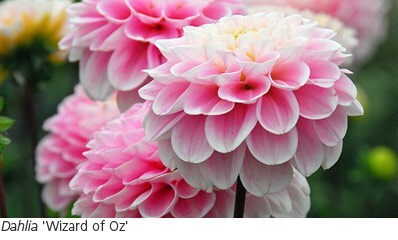
Pink and purple dahlias mix well with asters of every colour, as does the mauve-washed 'Eveline', which is mainly white with a purple wash and crisp purple edge. 'The Wizard of Oz', a fondant-pink decorative type with a whirl of neatly arranged petals, is just a foot high, so it's suitable for the front of the border or in a container. It's sold separately and also included in the Pastel Dahlia Collection along with 'Karma Prospero' and 'Blue Boy'.
Subtle Antiques
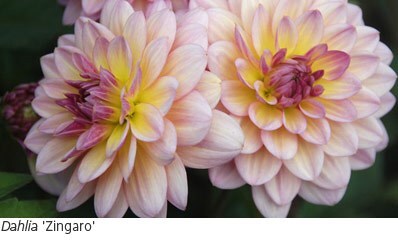
Paler colours are highly popular with flower arrangers and the large flowers of 'Café au Lait' have a warm coffee swirl at the centre of each large, ragged-petalled malted-milk flower. It is also part of the Antique Shades Collection, along with 'American Moon' and 'Zingaro'. Although the base colour is subtle cream there are shades of plum, pink and orange too, so these dahlias will blend with almost anything without fear of ever looking insipid.
Day-Glo Radiance
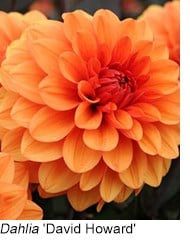 Strong, radiant colours light up late-summer and autumn, helped along by the crystal clear light so all day-glo dahlias make perfect touch-papers for blues and purples. The butterscotch-orange 'David Howard', a top flight dahlia, is excellent with blue flowers such Agastache 'Blue Fortune' and the khaki dahlia foliage adds even more depth. 'Karma Fuchsiana' is much more vivid, shimmering in the sunlight and jumping between orange, pink and salmon. This smoulders in the garden. Or you could consider the asymmetrical, whirligig flowers of 'Waltzing Mathilda' in a mouthwatering colour that combines cherries and ripe peaches. 'Jescott Julie' is one of the new orchid-flowered forms, with mustard-yellow petals streaked and splashed with tomato-red. These are all shorter with neat flowers that flow backwards. Strong, radiant colours light up late-summer and autumn, helped along by the crystal clear light so all day-glo dahlias make perfect touch-papers for blues and purples. The butterscotch-orange 'David Howard', a top flight dahlia, is excellent with blue flowers such Agastache 'Blue Fortune' and the khaki dahlia foliage adds even more depth. 'Karma Fuchsiana' is much more vivid, shimmering in the sunlight and jumping between orange, pink and salmon. This smoulders in the garden. Or you could consider the asymmetrical, whirligig flowers of 'Waltzing Mathilda' in a mouthwatering colour that combines cherries and ripe peaches. 'Jescott Julie' is one of the new orchid-flowered forms, with mustard-yellow petals streaked and splashed with tomato-red. These are all shorter with neat flowers that flow backwards.
Miniatures for Containers
 If there's a patio or balcony, some of the miniature dahlias containerise well and suitable candidates include the tiny-flowered Star Wars. Its dark foliage and masses of warmly toned flowers sit well in terracotta. The Happy Series contains some stunners and the dark-eyed bright pink 'Happy Single Wink' is one of the finest, with a dark middle ringed in orange stamens set in ox-blood red. Where the pink petals overlap there's a clear-red corolla of colour. The Dark Angel Series are also short, roughly a foot or so, and 'Pretty Woman' is aptly named. When the flowers open each sugar-pink flower, with a wine-red stain in the middle, gradually produces a ring of yellow stamens. Like all singles the flowers are worshipped by bees and butterflies and the Dark Angel Series all have dusky foliage. If there's a patio or balcony, some of the miniature dahlias containerise well and suitable candidates include the tiny-flowered Star Wars. Its dark foliage and masses of warmly toned flowers sit well in terracotta. The Happy Series contains some stunners and the dark-eyed bright pink 'Happy Single Wink' is one of the finest, with a dark middle ringed in orange stamens set in ox-blood red. Where the pink petals overlap there's a clear-red corolla of colour. The Dark Angel Series are also short, roughly a foot or so, and 'Pretty Woman' is aptly named. When the flowers open each sugar-pink flower, with a wine-red stain in the middle, gradually produces a ring of yellow stamens. Like all singles the flowers are worshipped by bees and butterflies and the Dark Angel Series all have dusky foliage.
More Cutting Garden Flowers
 It's very easy to dismiss gladioli and Barrie Humphrey's Edna Everage hasn't helped the gladdie's image one bit! However gladioli make good additions to a cutting garden, or they can be massed into a border. They come in exciting colours and forms and the aptly named 'Plum Tart' has ruffled pinkish-red flowers held on strong stems. Gladioli also provide rare summer glimpses of apple-green and 'Green Star', which has now replaced the old variety 'Green Woodpecker', is one of the best. Mix this with 'Purple Mate' for upright splendour, but whatever you do avoid any straight lines when planting. It's very easy to dismiss gladioli and Barrie Humphrey's Edna Everage hasn't helped the gladdie's image one bit! However gladioli make good additions to a cutting garden, or they can be massed into a border. They come in exciting colours and forms and the aptly named 'Plum Tart' has ruffled pinkish-red flowers held on strong stems. Gladioli also provide rare summer glimpses of apple-green and 'Green Star', which has now replaced the old variety 'Green Woodpecker', is one of the best. Mix this with 'Purple Mate' for upright splendour, but whatever you do avoid any straight lines when planting.
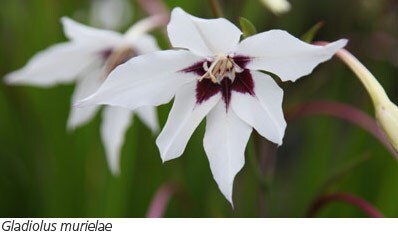
Not all gladioli are stiff and showy, the species are subtler in form and colour. Gladiolus × colvillii 'The Bride' has warm-white starry flowers softened by pink stamens. 'Nymph' is white with lipstick pink kisses on the petals and Gladiolus murielae is a nodding white with a maroon eye.
These subtler forms are worth planting in containers by a seat because they are fragrant, especially in the evenings. Or you could containerise an exotic Ginger lily such as Hedychium gardnerianum. The pallid-yellow flowers, which appear in late-summer, are studded with snuff-brown anthers and the foliage is positively banana-like. In warmer gardens it will overwinter in the ground. It's another fragrant beauty, again smelling strongly as the light fades. These are all summer pleasures to acquire now. |
|
Things to do
 |
Plant Autumn-Flowering Perennials

Spring is the time to plant autumn-flowering herbaceous perennials so that they settle in and flower this year. Echinaceas, heleniums, rudbeckias, asters and sedums will settle in well now. Later grasses (miscanthus, molinias, pennisetums and panicums) also benefit from spring planting. Anything slightly tender, such as penstemons, hardier fuchsias and salvias, can also be planted in spring.
|
 |
Cut Back Scruffy Plants
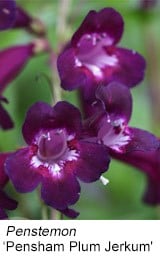
Once spring is here the weeds and the grass begin to grow. When you feel the growth surge, cut back any overwintering plants that have become ragged and this includes hardier salvias, penstemons, hardy English lavenders and many other silver-leaved plants.
|
 |
Plant Nerines
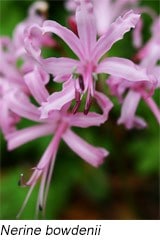
Plant nerine bulbs now and they will flower in late-autumn. Garden forms are listed under the name Nerine bowdenii. These are South African, despite their common name of Guernsey Lily, and they need good light and warmth. The Nerine Collection includes the soft-pink 'Ostara' and the white 'Ella K'. Nerine bulbs are planted up to their shoulders, not fully submerged, and they do not mind being tightly packed as they develop.
|
 |
Apply Fertiliser

Lots of plants will be springing back into life, but the rain-washed soil may be short of nutrients. You can add nutrients as well as improve the soil's structure by adding composted manure. Alternatively Vitax Q4 can be used to feed your roses, peonies and fruit. It's a sprinkle-on product that slowly releases food in a balanced ratio of NPK (5.3-7.5-10 + trace elements). This will produce good foliage, good roots and lots of flower power. It comes as a powder or in pelleted form.
|
 |
Plant Strawberry Runners
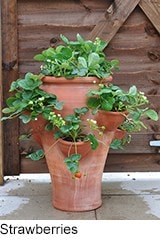
There's nothing quite as delicious as a home-grown, sun-ripened strawberry and this is the best time to plant bare-root plants - although you will have to wait until next summer for a bumper crop. There are two basic types. The summer-fruiting strawberry has early, mid and late varieties. These include the early, orange-fruited 'Honeoye', the mid-to-late 'Fenella' and the later variety 'Cupid'. Aromatic everbearers produce fruit over many months. The fruit is generally smaller with an alpine-strawberry flavour. However the new varieties such as 'Buddy' and 'Albion', combine the best of both. Choose a sunny position away from frost pockets and water well after planting.
|
|
|
Essential Kit for March

Bulb planters
from £12.99
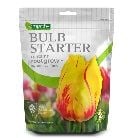
Bulb starter
was £6.99 now £5.99
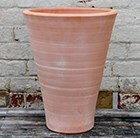
Empoli terracotta lily pot
from £24.99
|
|





















